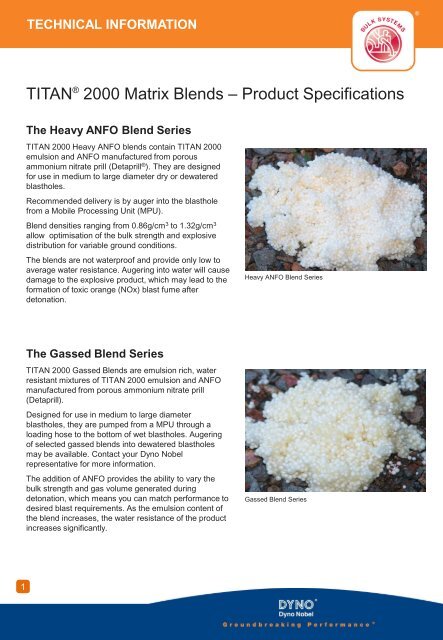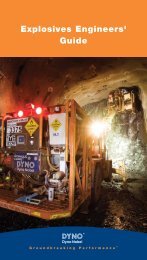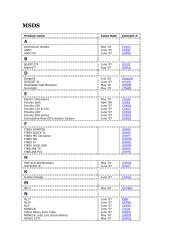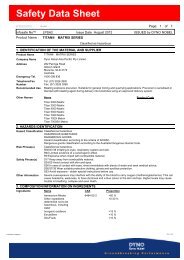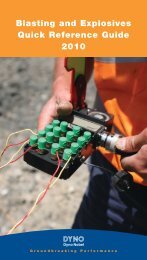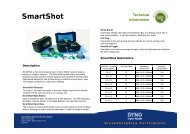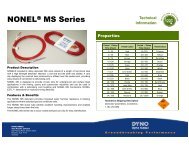TITAN® 2000 Matrix Blends – Product Specifications - Dyno Nobel
TITAN® 2000 Matrix Blends – Product Specifications - Dyno Nobel
TITAN® 2000 Matrix Blends – Product Specifications - Dyno Nobel
Create successful ePaper yourself
Turn your PDF publications into a flip-book with our unique Google optimized e-Paper software.
1<br />
TECHNICAL INFORMATION<br />
TITAN ® <strong>2000</strong> <strong>Matrix</strong> <strong>Blends</strong> <strong>–</strong> <strong>Product</strong> <strong>Specifications</strong><br />
The Heavy ANFO Blend Series<br />
TITAN <strong>2000</strong> Heavy ANFO blends contain TITAN <strong>2000</strong><br />
emulsion and ANFO manufactured from porous<br />
ammonium nitrate prill (Detaprill ® ). They are designed<br />
for use in medium to large diameter dry or dewatered<br />
blastholes.<br />
Recommended delivery is by auger into the blasthole<br />
from a Mobile Processing Unit (MPU).<br />
Blend densities ranging from 0.86g/cm 3 to 1.32g/cm 3<br />
allow optimisation of the bulk strength and explosive<br />
distribution for variable ground conditions.<br />
The blends are not waterproof and provide only low to<br />
average water resistance. Augering into water will cause<br />
damage to the explosive product, which may lead to the<br />
formation of toxic orange (NOx) blast fume after<br />
detonation.<br />
The Gassed Blend Series<br />
TITAN <strong>2000</strong> Gassed <strong>Blends</strong> are emulsion rich, water<br />
resistant mixtures of TITAN <strong>2000</strong> emulsion and ANFO<br />
manufactured from porous ammonium nitrate prill<br />
(Detaprill).<br />
Designed for use in medium to large diameter<br />
blastholes, they are pumped from a MPU through a<br />
loading hose to the bottom of wet blastholes. Augering<br />
of selected gassed blends into dewatered blastholes<br />
may be available. Contact your <strong>Dyno</strong> <strong>Nobel</strong><br />
representative for more information.<br />
The addition of ANFO provides the ability to vary the<br />
bulk strength and gas volume generated during<br />
detonation, which means you can match performance to<br />
desired blast requirements. As the emulsion content of<br />
the blend increases, the water resistance of the product<br />
increases significantly.<br />
Heavy ANFO Blend Series<br />
Gassed Blend Series<br />
®
2<br />
TECHNICAL INFORMATION<br />
TITAN ® <strong>2000</strong> <strong>Matrix</strong> <strong>Blends</strong> <strong>–</strong> <strong>Product</strong> <strong>Specifications</strong><br />
TITAN <strong>2000</strong><br />
<strong>Matrix</strong> Blend 1<br />
NOTES:<br />
Density<br />
(g/cm 3 ) 2<br />
Minimum Diam.<br />
(mm)<br />
Energy<br />
(MJ/kg) 3<br />
Typical VOD<br />
(m/s) 4<br />
RWS 5<br />
1. <strong>Dyno</strong> <strong>Nobel</strong> matrix blend names have a prefix indicating the emulsion type and a suffix indicating the emulsion weight %, with the<br />
remaining composition being ANFO. The addition of the letter “G” at the end indicates whether the product is gas sensitised eg<br />
TITAN 2070G = TITAN <strong>2000</strong> gassed blend containing 70 wt% emulsion or TITAN 2040 = TITAN <strong>2000</strong> heavy ANFO blend<br />
containing 40 wt% emulsion.<br />
2. Values are indicative average densities only, determined under laboratory conditions by <strong>Dyno</strong> <strong>Nobel</strong> technical personnel at <strong>Dyno</strong><br />
<strong>Nobel</strong>’s Mt Thorley Technical Centre. Observed densities may differ or vary under field conditions. Nominal in hole density only.<br />
For gassed products this is the average density. Use of the <strong>Dyno</strong> <strong>Nobel</strong> gassing table is required to determine the appropriate<br />
open cup density needed to achieve a toe density below the critical density for the hole depth.<br />
3. All <strong>Dyno</strong> <strong>Nobel</strong> energy values are calculated using a proprietary <strong>Dyno</strong> <strong>Nobel</strong> thermodynamic code <strong>–</strong> Prodet. Other programs may<br />
give different values.<br />
4. These results represent a range of Velocity of Detonation (VOD) collected from numerous <strong>Dyno</strong> <strong>Nobel</strong> blast sites throughout the<br />
Asia Pacific region over a period of time. The VOD actually recorded in use is dependent upon many factors, including: the<br />
initiation system used, the product density, blasthole diameter and ground confinement. The values stated are typical of those<br />
recorded for the product in various hole diameters, densities and ground types, and may not be achievable under all<br />
circumstances.<br />
RBS 6<br />
TITAN 2010 0.86 102 3.6 2300 <strong>–</strong> 5500 0.97 1.02<br />
TITAN 2020 0.97 102 3.4 2300 <strong>–</strong> 5500 0.94 1.11<br />
TITAN 2030 1.10 102 3.3 2500 <strong>–</strong> 5600 0.90 1.21<br />
TITAN 2040 1.25 127 3.2 2500 <strong>–</strong> 5600 0.87 1.32<br />
TITAN 2050 1.32 200 3.1 2800 <strong>–</strong> 5800 0.84 1.34<br />
TITAN 2050G 1.25 102 3.1 2800 <strong>–</strong> 5800 0.84 1.28<br />
TITAN 2060G 1.15 102 3.0 2800 <strong>–</strong> 5800 0.81 1.14<br />
TITAN 2070G 1.15 102 2.8 3500 <strong>–</strong> 5800 0.77 1.08<br />
TITAN 2080G 1.15 102 2.7 3500 <strong>–</strong> 5800 0.74 1.04<br />
TITAN 2090G 1.15 102 2.6 3800 <strong>–</strong> 6000 0.71 1.00<br />
TITAN <strong>2000</strong>G 1.15 102 2.5 3800 <strong>–</strong> 6000 0.68 0.98<br />
5. Relative Weight Strength (RWS) and Relative Bulk Strength (RBS) are determined using a density of 0.82g/cm 3 and an energy of<br />
3.7MJ/kg for ANFO.<br />
6. RBS has been calculated using the stated densities in the table above. RBS depends on the final density of the product at the time<br />
of loading.<br />
®
3<br />
TECHNICAL INFORMATION<br />
TITAN ® <strong>2000</strong> <strong>Matrix</strong> <strong>Blends</strong> <strong>–</strong> Selection Guide<br />
How to select the right TITAN <strong>2000</strong> product for your needs<br />
Select the appropriate TITAN <strong>2000</strong> product based on both the performance, as given by the product<br />
properties table, and the condition of the blasthole. Please consult your <strong>Dyno</strong> <strong>Nobel</strong> representative if further<br />
guidance regarding appropriate product selection is required.<br />
Under ideal conditions TITAN <strong>2000</strong> matrix blends may be slept for a maximum of 14 days. In non ideal<br />
conditions, sleep times should be reduced. The sleep times in the table below are recommended as a<br />
maximum sleep time to assist with minimisation of post blast fume. The Recommended Maximum Sleep<br />
Time is a guide for when the product is used in best case conditions however it is likely to be less in practice.<br />
Where site specific factors exist that make post blast fume a manageable risk; sleep times may be increased<br />
up to a maximum of 14 days following a site specific risk assessment, and the application of appropriate<br />
controls. Risk assessment should be conducted on a blast by blast basis.<br />
<strong>Product</strong> Emulsion % 10 20 30 40 50 60 70 80 90 100<br />
Blasthole<br />
Conditions<br />
<strong>Product</strong><br />
Use<br />
Dry 1 Use Yes<br />
RMST 2<br />
(Days)<br />
14 14 14 14 14 14 14 14 14 14<br />
Dewatered 3 Use No Yes<br />
RMST<br />
(Days)<br />
- - - 5 8 12 12 12 12 12<br />
Wet 4 Use No Yes<br />
RMST<br />
(Days)<br />
- - - - - 8 12 12 12 12<br />
Dynamic 5 Use No Yes<br />
RMST<br />
(Days)<br />
- - - - - - 5 8 8 8<br />
Sensitisation Required No Note 6 Yes 7<br />
Delivery Method Auger Pump<br />
NOTES:<br />
1. Dry hole is defined as a blasthole containing no water including no wet walls.<br />
2. RMST = Recommended Maximum Sleep Time (days).<br />
3. A dewatered hole is defined as not recharging with water.<br />
4. A wet hole is defined as a blasthole containing static water.<br />
5. Dynamic water is defined as a recharge rate of >1m in 30 minutes. If the level of dynamic water is such that product damage is<br />
suspected or observed, the suggested RMST should be reduced.<br />
6. Emulsion blends containing 50% emulsion are typically auger loaded. This product has reduced sensitivity and is recommended<br />
for hole depths less than 25m. Sensitisation is required for use in holes deeper than 25m. Please consult your <strong>Dyno</strong> <strong>Nobel</strong><br />
representative to check which delivery options are available at your location.<br />
7. The <strong>Dyno</strong> <strong>Nobel</strong> Gassing Table should be used to determine the appropriate open cup density for the hole depth.<br />
®
4<br />
TECHNICAL INFORMATION<br />
TITAN ® <strong>2000</strong> <strong>Matrix</strong> <strong>Blends</strong> <strong>–</strong> Usage Information<br />
What to know about using TITAN <strong>2000</strong> <strong>Blends</strong><br />
Priming Requirements <strong>–</strong> TITAN <strong>2000</strong> matrix blends<br />
are booster sensitive and require a minimum 400g<br />
cast booster . Smaller booster types may reduce the<br />
performance of the explosive. Additional boosters<br />
should be used when the column height exceeds 10<br />
to 15 metres or where there is risk of column<br />
disruption. Please consult your <strong>Dyno</strong> <strong>Nobel</strong><br />
representative if you intend using detonating cord<br />
down lines.<br />
Maximum Hole Depth <strong>–</strong> TITAN 2040 and lower<br />
emulsion content blends can be detonated<br />
successfully in depths up to 75m. TITAN 2050 may<br />
be used without sensitisation in depths up to 25m.<br />
Titan 2050G may be used in depths up to 60m.<br />
Maximum hole depths for TITAN 2060G and higher<br />
emulsion content blends are determined by the level<br />
of sensitisation.<br />
Sensitisation <strong>–</strong> TITAN <strong>2000</strong> gassed blends are<br />
chemically sensitised as the product is delivered to<br />
the blasthole. Allow at least 30 minutes at 20°C for<br />
the reaction to occur before the blasthole is stemmed<br />
(longer at lower temperatures). The level of<br />
sensitisation necessary (as given by the open cup<br />
density) is dependent on the depth of the blasthole.<br />
As a guide, the maximum open cup densities for the<br />
following depths are as follows:
5 5<br />
TECHNICAL INFORMATION<br />
TITAN ® <strong>2000</strong> <strong>Matrix</strong> <strong>Blends</strong> <strong>–</strong> Usage Information<br />
A guide to safe handling, transport and storage<br />
First Aid <strong>–</strong> You can find detailed first aid information on the relevant <strong>Dyno</strong> <strong>Nobel</strong> Material Safety Data Sheet.<br />
Refer to www.dynonobel.com for more information if required.<br />
Safety <strong>–</strong> TITAN <strong>2000</strong> <strong>Matrix</strong> (explosive precursor), Heavy ANFO blends and gassed blends (explosives) are<br />
classified as dangerous goods and can cause personal injury and damage to property if used incorrectly.<br />
Transportation and Storage <strong>–</strong> All <strong>Dyno</strong> <strong>Nobel</strong> emulsions matrices and explosives must be handled,<br />
transported and stored in accordance with all relevant regulations. Stock should be rotated such that older<br />
product is used first.<br />
Dangerous Goods Classification<br />
<strong>Product</strong> Name: TITAN <strong>2000</strong> HANFO <strong>Blends</strong><br />
TITAN <strong>2000</strong> Gassed <strong>Blends</strong><br />
Correct Shipping Name: Explosive, Blasting, Type E<br />
UN Number: 0241<br />
DG Class: 1.1D<br />
®
6<br />
TECHNICAL INFORMATION<br />
TITAN ® <strong>2000</strong> <strong>Matrix</strong> <strong>Blends</strong> <strong>–</strong> Gassing Table<br />
DENSITY OF TITAN 2060G (AND HIGHER EMULSION<br />
CONTENT BLENDS) IN AN EXPLOSIVE COLUMN AT<br />
DIFFERENT DEPTHS FOR DIFFERENT OPEN CUP<br />
DENSITIES<br />
DEPTH<br />
(m)<br />
OPEN CUP DENSITY (g/cc)<br />
0.90 0.95 1.00 1.05 1.10 1.15 1.20 1.25<br />
1 0.92 0.97 1.02 1.07 1.12 1.17 1.21 1.26<br />
2 0.95 0.99 1.04 1.09 1.13 1.18 1.22 1.26<br />
3 0.97 1.01 1.06 1.10 1.15 1.19 1.23 1.27<br />
4 0.98 1.03 1.08 1.12 1.16 1.20 1.24 1.27<br />
5 1.00 1.05 1.09 1.13 1.17 1.21 1.24 1.28<br />
6 1.02 1.06 1.10 1.14 1.18 1.21 1.25 1.28<br />
7 1.03 1.07 1.11 1.15 1.19 1.22 1.25 1.28<br />
8 1.04 1.08 1.12 1.16 1.19 1.23 1.26 1.28<br />
9 1.06 1.10 1.13 1.17 1.20 1.23 1.26 1.29<br />
10 1.07 1.11 1.14 1.18 1.21 1.24 1.26 1.29<br />
12 1.09 1.12 1.16 1.19 1.22 1.24 1.27 1.29<br />
14 1.10 1.14 1.17 1.20 1.23 1.25 1.27 1.29<br />
16 1.12 1.15 1.18 1.21 1.23 1.26 1.28 1.30<br />
18 1.13 1.16 1.19 1.22 1.24 1.26 1.28 1.30<br />
20 1.14 1.17 1.20 1.22 1.25 1.27 1.28 1.30<br />
24 1.16 1.19 1.21 1.24 1.25 1.27 1.29 1.30<br />
28 1.18 1.20 1.23 1.24 1.26 1.28 1.29 1.30<br />
32 1.19 1.22 1.23 1.25 1.27 1.28 1.29 1.31<br />
36 1.20 1.22 1.24 1.26 1.27 1.29 1.30 1.31<br />
40 1.21 1.23 1.25 1.26 1.28 1.29 1.30 1.31<br />
45 1.22 1.24 1.26 1.27 1.28 1.29 1.30 1.31<br />
50 1.23 1.25 1.26 1.27 1.28 1.29 1.30 1.31<br />
55 1.24 1.25 1.27 1.28 1.29 1.30 1.30 1.31<br />
60* 1.25 1.26 1.27 1.28 1.29 1.30 1.31 1.31<br />
65* 1.25 1.26 1.27 1.28 1.29 1.30 1.31 1.31<br />
70* 1.26 1.27 1.28 1.29 1.29 1.30 1.31 1.31<br />
75* 1.26 1.27 1.28 1.29 1.30 1.30 1.31 1.31<br />
80* 1.26 1.27 1.28 1.29 1.30 1.30 1.31 1.31<br />
* Contact your <strong>Dyno</strong> <strong>Nobel</strong> representative for further information on<br />
pumping into holes with a depth equal to or greater than 60m.<br />
Densities in bold (highlighted) are near the critical<br />
density of the explosive and the respective open cup<br />
densities should not be used for that depth of explosive<br />
column.<br />
USE OF TABLE 1<br />
1. The left hand column in this table (Depth) indicates the<br />
height of the product column under dry hole<br />
conditions. In wet hole conditions the value selected<br />
from the left hand column must be the sum of the<br />
product column plus the height of the water column in<br />
the hole. If the height of the product and water column<br />
exceeds the depth of the hole then the value selected<br />
from the left hand column must be the hole depth.<br />
2. This table applies for TITAN <strong>2000</strong> <strong>Matrix</strong> blends with<br />
an emulsion content of 60 wt % or greater.<br />
3. Emulsion explosives behave as liquids when<br />
subjected to the gravitational stress in a vertical<br />
blasthole, and a pressure gradient in the explosive will<br />
be established. The higher the explosive column in the<br />
blasthole, the higher the internal pressure at the<br />
bottom of the column, and the larger the quantity of<br />
gassing chemicals which need to be added to provide<br />
sensitisation.<br />
4. The open cup density is a measure of the level of<br />
sensitisation of the product. The columns of the Table<br />
indicate the likely density profile with depth to be found<br />
in the explosive column for a certain open cup density.<br />
It is necessary to choose an open cup density to<br />
ensure that the density of the explosive at the bottom<br />
of the blasthole is less than the critical density.<br />
5. To determine the required open cup density for an<br />
explosive column of 50m (say), find 50m in the Depth<br />
column. Moving to the right, read off the density<br />
immediately before the bolded density data begins<br />
(here, 1.26g/cm 3 in the 1.00 g/cm 3 open cup density<br />
column). This indicates that sufficient gassing<br />
chemicals should be added to the gassed explosive<br />
blend during delivery so that an open cup density of<br />
1.00g/cm 3 is achieved. This level of gassing chemicals<br />
will ensure that the density at the bottom of the column<br />
will be below the critical density, and the column will<br />
detonate upon initiation.<br />
6. To determine the approximate average in-hole<br />
density of the gassed product loaded, locate the<br />
Open Cup Density column used and read off the<br />
density value for half the depth of the blasthole. For<br />
depths that are not listed, use the nearest given value.<br />
7. The gassing reaction takes 30-40 minutes to achieve<br />
the desired open cup density at 20°C. It is necessary<br />
to allow at least this time to elapse between<br />
completion of loading and stemming the charged<br />
blasthole. A longer period should be allowed at lower<br />
temperatures.<br />
8. The density values shown were calculated using a<br />
laboratory validated mathematical model.<br />
®
7<br />
TECHNICAL INFORMATION<br />
<strong>Dyno</strong> <strong>Nobel</strong> Asia Pacific<br />
Queensland<br />
Remember, the explosive products discussed in this document should only be handled by persons with the appropriate<br />
technical skills, training and licences.<br />
While <strong>Dyno</strong> <strong>Nobel</strong> has made every effort to ensure the information in this document is correct, every user is<br />
responsible for understanding the safe and correct use of the products. If you need specific technical advice or have<br />
any questions, you should contact your <strong>Dyno</strong> <strong>Nobel</strong> representative.<br />
This information is provided without any warranty, express or implied, regarding its correctness or accuracy and, to the<br />
maximum extent permitted by law, <strong>Dyno</strong> <strong>Nobel</strong> expressly disclaims any and all liability arising from the use of this<br />
document or the information contained herein. It is solely the responsibility of the user to make enquiries, obtain advice<br />
and determine the safe conditions for use of the products referred to herein and the user assumes liability for any loss,<br />
damage, expense or cost resulting from such use.<br />
<strong>Dyno</strong> <strong>Nobel</strong> Asia Pacific Pty Limited (ACN 003 269 010) is a subsidiary of Incitec Pivot Limited (ACN 004 080 264)<br />
® DYNO, GROUNDBREAKING PERFORMANCE, TITAN and DETAPRILL are registered trademarks of the <strong>Dyno</strong> <strong>Nobel</strong> / Incitec Pivot Limited Group.<br />
DX5043 is a trademark of the <strong>Dyno</strong> <strong>Nobel</strong> / Incitec Pivot Limited Group.<br />
© <strong>Dyno</strong> <strong>Nobel</strong> Asia Pacific Pty Limited 2011. Reproduction without permission is prohibited.<br />
September 2011<br />
VERSION 6.0<br />
New South Wales<br />
Western Australia<br />
Indonesia<br />
Principal Place of Business Mt Thorley Technical Centre Perth Office Jakarta Office<br />
282 Paringa Road<br />
Gibson Island<br />
Murarrie QLD 4172<br />
Australia<br />
PO Box 3559<br />
Tingalpa DC QLD 4173<br />
Australia<br />
Telephone: +61 7 3026 3900<br />
Fax: + 61 7 3026 3999<br />
5 Woodland Road<br />
Mt Thorley NSW 2330<br />
Australia<br />
PMB 17<br />
Singleton NSW 2330<br />
Australia<br />
Telephone: + 61 2 6574 2500<br />
Fax: + 61 2 6574 6849<br />
Suite 3, Level 2<br />
Eastpoint Plaza<br />
233 Adelaide Terrace<br />
Perth WA 6000<br />
Australia<br />
Telephone: + 61 8 6188 3000<br />
Fax: + 61 8 9325 4910<br />
PT dnx Indonesia<br />
Park View Plaza, 1/F<br />
Jl. Taman Kemang 2 No. 27<br />
Jakarta<br />
Indonesia 12730<br />
Telephone: +62 21 7179 4791<br />
Fax: +62 21 7179 4794<br />
Papua New Guinea<br />
For PNG enquiries,<br />
contact the Gibson Island,<br />
Brisbane office<br />
®


